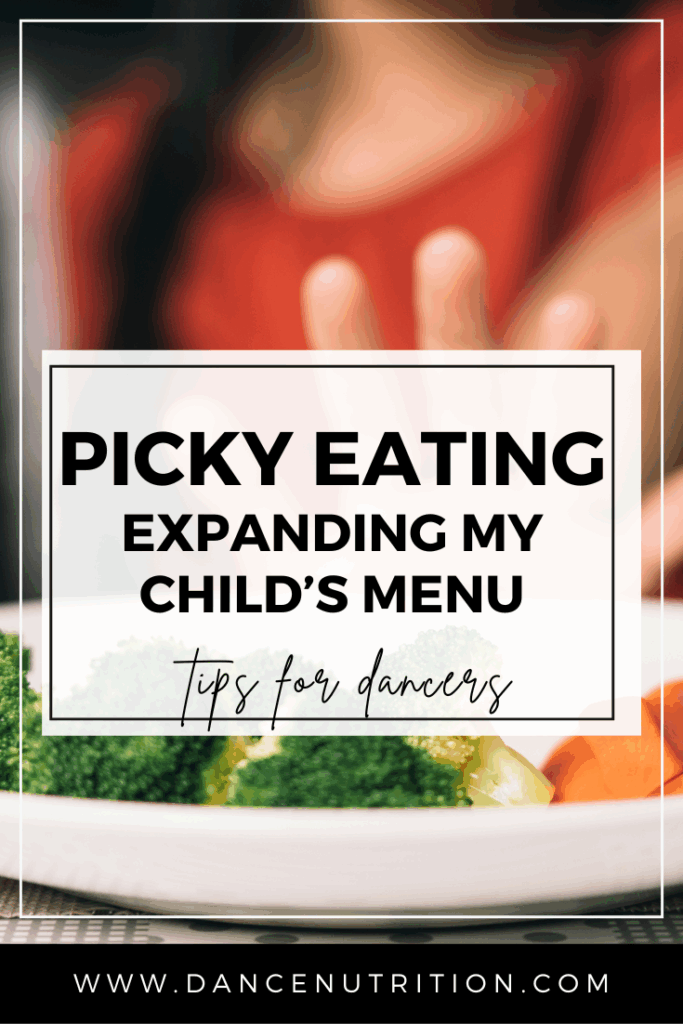Can Picky Dancers Expand Their Menu?
For young dancers, nutrition plays an essential role in supporting growth beyond their performance. This means a double whammy: energy for dance and energy for baseline growth. Yet, picky eating presents additional challenges that can stand in the way of these goals.
There’s a spectrum when we consider the depths of food pickiness. More severe cases like Avoidant/Restrictive Food Intake Disorder (ARFID) can present clinical concerns. Signs may include significant weight loss, anxiety around food, or sensory aversions. Regular check-ins with healthcare providers are key, especially if growth falters, energy levels drop, performance suffers, or psychological stress around meals increases.
Picky eating often has genetic roots, particularly in early years, but environmental and nurturing strategies strongly influence how it evolves over time. The good news: with patience, structure, and support, even selective eaters can expand their menu.
What Not To Do
Before we dive into age-specific strategies, it’s important to note what can backfire:
- Don’t use food as a reward or punishment. It ties eating to behavior, not hunger or enjoyment.
- Don’t pressure or force bites. This often increases resistance.
- Don’t label foods as “good” or “bad.” Labels can create guilt and shame later on.
- Don’t serve completely separate meals. Instead, include at least one familiar food alongside the family meal.
- Don’t ignore red flags. If growth or health is impacted, consult a pediatrician or dietitian.
The goal is not to “fix” picky eating, but to nurture curiosity, safety, and a positive relationship with food. Let’s break down the stages of development and the strategies that can help.
Toddlerhood (Ages 2–4): Building Solid Foundations
Around 20–60% of young children are considered picky eaters, with rates peaking around age 2. In preschoolers, picky eating has been linked to lower growth measures (weight, height, and BMI). For dancers, this stage is about laying a foundation for consistent, supportive eating.
How to help:
- Offer small, scheduled meals and snacks to stabilize appetite patterns.
- Keep mealtimes low-pressure: always serve one familiar food with any new option.
- Use repeated, playful exposures— think colorful plates, fun shapes, and sensory games.
- Stay calm with refusals: consistency and repetition are what count.
Early School Age (Ages 5-7): Expanding Palates
At this stage, many children begin to outgrow picky habits, though some still need gentle guidance. By age 13, most have caught up nutritionally, but until then, steady exposure is key.
Flexible day-to-day structure means a morning meal, afternoon meal, and evening meal with 1-3 multi-component snacks between. By 5, children can begin understanding the differences between nourishing foods and fun foods— setting the stage for building a supportive relationship with food.
How to help:
- Introduce new foods in familiar formats (like a new veggie in a favorite pasta).
- Use simple, empowering language: “Bread gives us energy; protein helps our muscles.”
- Encourage meal prep participation— ownership builds openness.
- Keep language food-neutral. Avoid calling some foods “junk” or “bad.” Here’s an article to learn about alternatives.
- Use supplements (like kid-friendly nutritional shakes) only if recommended by your pediatrician or dietitian, and never in place of full meals.
- Make the process fun. I’ve created these food charts that help to increase motivation. Here’s a link to customize yours.
Middle Childhood (Ages 8-10): Connecting Nutrition to Performance
By this age, dancers’ training demands increase, and even non-picky eaters can fall short on energy— leading to fatigue, menstrual issues, decreased bone density, and increased injury risk. The silver lining? Kids start to connect the dots between food and how they feel in the studio.
How to help:
- Pack lunches and snacks that meet both preferences and performance needs. Start here for ideas.
- Involve dancers in grocery shopping and lunchbox planning.
- Introduce new foods gradually— pair small portions with safe favorites (for example, if your dancer loves a milkshake, try adding a banana and a spoonful of peanut butter).
- Highlight performance links: “This snack will help your legs jump higher in rehearsal,” or “Pairing these foods together helps us feel energized for longer.“
Adolescence (Ages 11–Teen Years): Strengthening & Safeguarding
This stage brings unique challenges: puberty, higher training loads, and increased pressure from the dance world. Picky eating here may overlap with disordered eating, raising the risk of injury and burnout.
How to help:
- Partner with a Registered Dietitian Nutritionist to ensure balanced fueling.
- Teach about RED-S: the importance of meeting calorie needs, regular menstruation, and bone health.
- Create a safe, empowering food environment where nourishment is seen as strength.
- Encourage social media safety— avoid accounts promoting restrictive diets or harmful body ideals.
- Reinforce resilience, skill, and artistry over appearance or weight.
Key Takeaways: Picky Eating Dancers
Picky eating is common and often resolves with time, but for dancers, food variety is key to accessing the spectrum of nutrients needed for performance. With patience and consistency, dancers can build the skills to expand their menus while fueling both growth and performance. Remember:
- Patience first. Gentle exposure works better than pressure.
- Structure matters. Routine meals and snacks support appetite and reduce stress.
- Food is fuel. As dancers grow, connect nutrition to energy, artistry, and recovery.
- Stay food-neutral. Avoid moralizing food choices.
- Watch for red flags. If picky eating affects growth, health, or mental well-being, seek professional guidance.
- Build support. A Registered Dietitian Nutritionist with dance expertise can help your dancer thrive.



